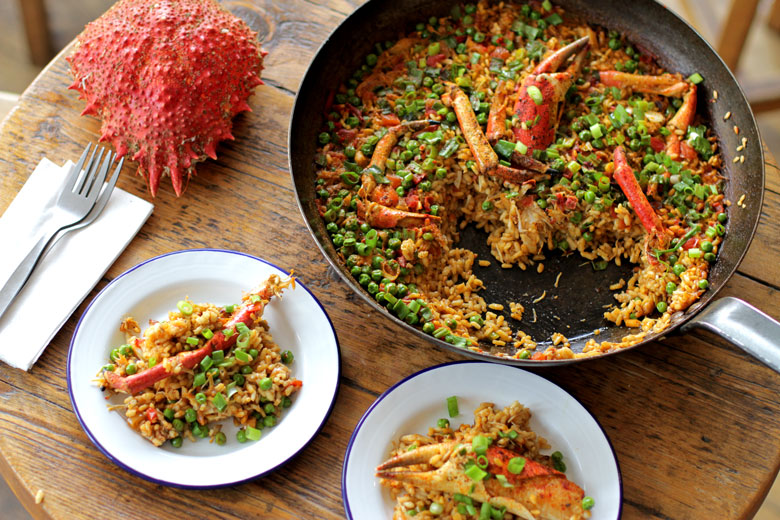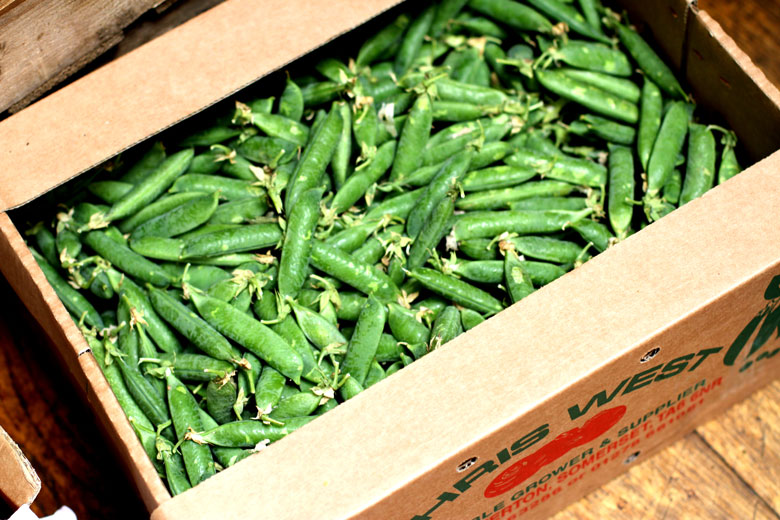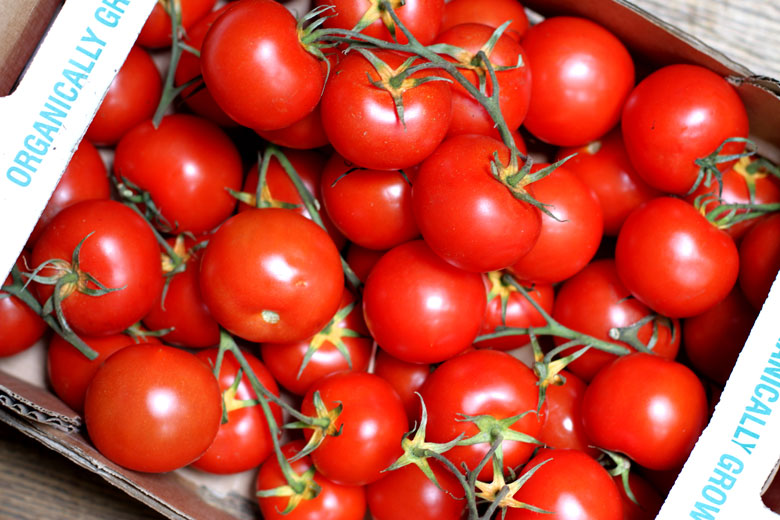July
Festivals, dab, sea bass, sardines, courgettes, apricots and a sensational paella starring the wonderful spider crab. Tom Hunt celebrates what we can enjoy this month.

July is a month of summer celebration, festivals and barbecues. My latest barbecue discovery, which I’ve written about on this blog before, is a rather adventurous whole brown crab. The crab is placed directly on the coals to char and steam in its shell. Being in such close contact with the source of heat and without contact with water, the crab meat becomes rich and intense with a wonderful smoky flavour.
Cooking over charcoal will always be my favourite way of preparing seafood, but there’s plenty more ways to eat your choice of fresh fish and crustacea. Ceviche is another favourite of mine, perfect for scorching hot summer days: check out my drunken prawn ceviche recipe. This month I recommend substituting the prawns with sea bass, either wild or farmed.
Now in season, it has a brilliantly firm white flesh and is somewhat of a delicacy. It takes well to this magical Peruvian treatment, but be careful not to mask its subtle flavour with too much chilli. Choose mild red chillies like a jalapeno or aji amarillo. Sea bass is costly, so get the most bang for your buck and use the carcass to make a wonderfully flavoured, clear stock. Pop it in the freezer until you’ve got a free 30 minutes to simmer the stock in a pot with some collected veg trimmings.

Dab is also good this month. A small flat fish, dab is one of the most abundant fish in the sea according to studies by the Marine Conservation Society. A whole dab makes a good portion for one. Pre-heat the oven to 200°C, drizzle with olive oil and sprinkle with a little salt. Roast for 10 minutes, then serve with a wedge of lemon.
My polytunnel and veg patch are now bulging with glorious summer vegetables: bell peppers, aubergines, broad beans, new season beetroot, onions, and garlic. The courgettes are also in abundance, their vines stretching across the veg patch adorned with remarkable, brilliant yellow flowers, ready for stuffing with soft cheese and anchovies.

Towards the end of the month we’ll also see British apricots in our markets and glowing orange on our greengrocer’s shelves. British apricots can be hard to come by and their season is short, lasting only until September. They are worth seeking out; as British apricots are picked relatively locally they’re riper, allowing the flesh to stay firm but sweet. Try tearing them into salads with bitter leaves, dressed with lemon and served with grilled sardines.
Today I’m cooking a monster of the deep, spider crab, which is similar to brown crab but with long spider-like legs and a spiny carapace. Spider crab contains less meat than brown crab, but it is much sweeter. Most spider crabs caught in the UK are shipped to Spain. This seems a shame to me when we have this lovely food on our doorstep. They’re delicious boiled and served as they are, or drizzled with extra virgin olive oil and nada mas, as they are in Spain. They’re also a real favourite with the locals in Latin America, where I used to work in an Argentinian grill: we’d serve the biggest spider crabs boiled and cracked to our customers on the beach.

Spider crab and pea paella
This is a great summer recipe: such a lovely dish to share with friends. Use a paella pan if you can, otherwise a large, deep frying pan will do the trick. The brown crab meat gives the most amazing rich creamy texture. This recipe is a simplified adaptation of Alberto Herráiz’s recipe in his amazing book, Paella.
Ingredients
About 1.5kg spider crab, boiled and picked with the claws and a few of the legs left intact (save the cooking water)
Alternatively buy 300g of mixed brown crab meat
8 spring onions, finely sliced, separate the white from the green
2 garlic clove, chopped
2 tsp smoked paprika
3 tomatoes, finely diced
500g paella rice
150g peas or broad beans (about 400g in the pods). Add the shells to the crab stock if boiling
Method
Preheat the oven to 180°C
Gently fry the white half of the spring onion with the garlic, paprika and tomatoes for five minutes. Add the rice, stir and fry for a further two minutes.
If you prepared your own crab bring the stock to the boil, otherwise boil the kettle.
Mix in the crab meat and peas or broad beans if using. Cover the rice with one litre of the hot crab stock or hot water if you bought your crab meat ready picked. Stir the rice and crab so that it sits evenly around the pan. Bring to the boil and simmer for 5 minutes until the rice rises to the surface of the stock. Decorate the surface with the crab claws and some of the legs. Place in the oven for 15 minutes. Remove from the oven and cover with a tea towel for two minutes.
Serve sprinkled with the rest of the spring onions and a wedge of lemon. The rice should be firm to the bite and full of flavour.
Tom Hunt is author of The Natural Cook: Eating the Seasons from Root to Fruit. He founded the Forgotten Feast, a campaign working on projects throughout the UK, to revive our cooking heritage and help reduce food waste and Poco, a festival café and award-winning restaurant in Bristol and (just opened) London’s Broadway Market. Click here to read his blog, Tom’s Feast.





